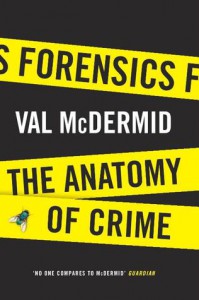

Forensics: The Anatomy of Crime
by Val McDermid
When I saw a book on forensics written by Val McDermid on Netgalley, I knew I had to get my hands on it. Given the talent for viscerally creepy psychological thrillers that McDermid has displayed in her Tony Hill novels, I was excited to see what she would make of nonfiction.
Forensics is as riveting as I had anticipated. McDermid isn’t just a talented writer; she also does her research. In this book, she proves it. Each chapter discusses a different discipline of forensics: crime scene analysis, fire investigation, forensic entomology, pathology, toxicology, fingerprinting, blood spatter, DNA, anthropology, facial reconstruction, digital forensics, forensic psychology, and, last, the courtroom. Enlivened by interviews with experts and stories of individual cases, each chapter melds together the history of the discipline with modern-day practices, challenges, and triumphs.
Even though I’m an inveterate reader of detective novels with a tendency to read nonfiction forensics books, I learned a ton from this book. For example, I didn’t know that the first book on forensic entomology, The Washing Away of Wrongs, was published in 1247 in China. I had no idea that the diatom composition in the remains of a match found at a fire scene can be used to identify the brand, or that 97% of fires in Scotland are investigated by people with less than a week of training in fire scene investigation, or that serial killers generally live within the triangle formed by their first three victims. Although I’d heard of Bernard Spilsbury, the charismatic and dogmatic pathologist who acted as an expert witness in over 200 trials, I had no idea that his evidence on Crippen (of the Brides-in-the-Bath fame) was conclusively proved to be false.
While the facts are fascinating in their own right, the stories were even better. McDermid weaves individual cases into each chapter that serve to illuminate various themes. Even those I’d heard before, such as the history of fingerprints or the sordid tale of “inheritance powder” (a.k.a arsenic), McDermid’s style was sharp and vivid enough to hold my attention throughout. One of my favourite stories was the first case in which a bullet was forensically traced back to a specific gun: a lady summoned the Bow Street Runners to her house, where a robbery occurred and her butler was apparently wounded in the struggle with the burglar. Long story short, the butler actually did do it, and the gun told the tale. Or there’s the “Phantom of Heilbronn,” a mysterious, apparently supernaturally speedy serial killer whose DNA was found in a massive series of unconnected cases across Europe. (The DNA turned out to be from a woman at a cotton swab factory-- a lesson in using materials that weren’t certified for forensic use.)
Throughout, McDermid emphasizes that forensics is more an art than a science, and that treating such evidence as infallible is terribly dangerous. McDermid goes into detail about the miscarriages of justice made by overconfident courtroom personalities like Spilsbury, and the self-fulfilling prophecy and stage-magic of early forensic psychology, and the potential political and racial pitfalls of familial DNA searches. Although she details the problems with the adversarial justice system, and the ways that attacks on the personalities of expert witnesses strain and even pervert the system, she sees it as crucial to the overall system. It’s not a perfect system--as one of McDermid’s interviewees, Fiona Raitt, said:
"There is deep reluctance for governments to explore what juries do. It is probably too terrifying."
It may be the best we have. Although each forensic discipline is imperfect, together they can be melded into a case that can withstand the pressure of the court to give us the closest thing to truth that we can obtain.
If you’re looking for casual nonfiction, then I'd definitely recommend this as one of the most entertaining and informative books on forensics that I've ever read.
~~I received an advanced reader copy of this book through Netgalley from the publisher, Grove Atlantic, in exchange for my honest review.~~

 13
13




